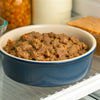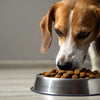Can My Dog Eat Wet Food Every Day? Understanding the Benefits, Considerations, and Best Practices
- Houndsy
Table of Contents
- Introduction
- The Nutritional Value of Wet Dog Food
- Benefits and Drawbacks of Feeding Wet Food Daily
- Transitioning to Wet Food
- Best Practices for Feeding Wet Food
- Addressing Common Misconceptions
- Conclusion and Final Thoughts
Introduction
Have you ever watched your dog sniff and nudge their dry kibble, only to turn away in disinterest? If so, you're not alone. Many dog owners grapple with the question of whether to transition their pups to a wet food diet, and a common concern surfaces: Can my dog eat wet food every day?
In the vast landscape of pet nutrition, understanding the implications of feeding wet food daily can make the difference between a happy, healthy dog and one who is reluctant to eat. Today's blog post will focus not only on whether wet food is suitable for daily feeding, but also on the potential benefits, concerns, and practical approaches to incorporating it into your dog’s diet seamlessly.
By the end of this article, you'll have a comprehensive understanding of how wet dog food can fit into your feeding routine, as well as insights into why many pet owners—including those aligned with Houndsy’s commitment to quality and convenience—choose to feed their dogs wet food regularly.
Key Points to be Covered:
- The Nutritional Value of Wet Dog Food
- Benefits and Drawbacks of Feeding Wet Food Daily
- Transitioning to Wet Food
- Best Practices for Feeding Wet Food
- Addressing Common Misconceptions
- Conclusion and Final Thoughts
Let’s dive in!
The Nutritional Value of Wet Dog Food
To grasp why wet food can be a great daily option, we need to examine its nutritional value. Wet dog food typically contains higher moisture content than dry kibble—often around 75%-80%. This feature alone is beneficial for dogs that might struggle with hydration.
Ingredients and Nutritional Balance
High-quality wet dog foods boast protein sources that can include real meat, vegetables, and grains tailored to meet your dog’s specific dietary needs. However, reading labels is crucial. Look for brands that specify meat as the primary ingredient without fillers and artificial additives.
Complete Nutrition
Most reputable wet dog foods are designed to deliver complete and balanced nutrition, making them suitable for everyday feeding. Popular formulas ensure that dogs receive essential nutrients like vitamins, minerals, and amino acids—vital for maintaining overall health.
Benefits and Drawbacks of Feeding Wet Food Daily
Now that we've established the nutritional landscape, it's important to weigh the benefits and potential drawbacks of feeding your dog wet food every day.
Benefits of Wet Food
-
Enhanced Palatability: Wet food is often more aromatic and flavorful than dry kibble. This characteristic is especially useful for picky eaters or dogs recovering from illness, as they may be more inclined to eat a food that smells and tastes better.
-
Increased Hydration: For dogs that don't drink enough water, the moisture from wet food helps keep them hydrated—crucial for kidney health and overall well-being.
-
Easier Digestion: Wet food can be easier on the digestive system, especially for puppies or older dogs with dental issues, who may have difficulty chewing dry kibble.
-
Weight Management: Many wet food diets are lower in calories and can promote a feeling of fullness, assisting in weight control.
Drawbacks of Feeding Wet Food
-
Dental Health Concerns: Due to its soft texture, wet food does not provide the scraping action on teeth that dry kibble offers, which may lead to tartar buildup. Regular dental care should be observed if you opt for a wet food diet.
-
Preservation and Storage: Once opened, wet food must be stored properly to prevent spoilage. It’s also essential to monitor serving sizes to avoid overfeeding—all facts that require more diligence than you might need with dry kibble.
-
Cost: Wet dog food generally costs more than dry kibble, which can be a factor for budget-conscious pet owners.
Transitioning to Wet Food
If you're considering making the switch to wet food, doing so gradually is essential. Abrupt changes can upset your dog’s stomach, leading to gastrointestinal issues.
Steps for Transition
-
Start Slow: Begin by mixing a small amount of wet food with your dog’s existing dry food. This could be a 70% dry to 30% wet ratio.
-
Gradual Increase: Over the course of several days, gradually increase the amount of wet food while decreasing the dry food until you reach your desired ratio or full transition.
-
Monitor Reactions: Watch for any signs of digestive upset, and give your dog time to adapt to the new textures and flavors.
Best Practices for Feeding Wet Food
Knowing how to incorporate wet food effectively into your dog’s routine can enhance their feeding experience. Here are some best practices:
-
Portion Control: Use feeding guidelines on the packaging as a reference, but adjust based on your dog's size, breed, age, and activity level.
-
Mix It Up: Some pet owners find success in alternating wet and dry foods. With our Houndsy Kibble Dispenser, transitioning between wet and dry food becomes convenient, allowing you to keep your dog's feeding routine simple and organized.
-
Regular Feeding Schedule: Maintain a consistent feeding schedule to regulate meal times and minimize digestive distress.
-
Dental Care: To offset the potential dental issues associated with exclusively wet diets, implement regular dental check-ups and consider dental chews or treats.
-
Storage: After opening, store leftover wet food in an airtight container in the refrigerator and assess any changes in your pet’s eagerness to eat based on temperature and freshness. Working with a warm meal can often entice even the most finicky eaters!
Addressing Common Misconceptions
While many myths surround wet dog food, it’s essential to distinguish fact from fiction.
Common Myths Explored
-
Myth: Wet food is only a treat.
- Truth: Quality wet food offers complete nutrition, making it suitable for daily feeding.
-
Myth: Wet food causes diarrhea.
- Truth: Generally, wet food is easier to digest. If diarrhea occurs, it may result from other dietary changes or an intolerance to specific ingredients.
-
Myth: Dogs will gain weight if fed wet food.
- Truth: When properly portioned, wet dog food can help maintain or even assist in weight management thanks to its filling properties.
-
Myth: Dogs don’t need variety.
- Truth: Just as we relish variety in our diets, dogs enjoy it too! Rotate flavors and brands to ensure diverse nutrient intake.
Conclusion and Final Thoughts
To wrap up, the answer to, "Can my dog eat wet food every day?" is a confident yes! Provided your chosen brand is nutritionally balanced and your dog enjoys it, wet food can be a delightful addition or even the mainstay of their diet.
As pet owners, we have the opportunity to enrich our dogs' feeding experiences, ensuring they receive both the nutrition they deserve and the flavors they crave. If you’re looking to elevate your dog's feeding ritual with style and convenience, consider exploring the Houndsy Kibble Dispenser here.
FAQ
Can puppies eat wet food every day? Yes, puppies can enjoy wet food daily, especially during weaning, as it is easy for their developing teeth to handle.
Is it okay to mix wet and dry food? Absolutely! Mixing can provide a balanced meal experience. Just ensure you're not overfeeding by adjusting portion sizes accordingly.
How should I store wet food? After opening, store wet food in a sealed container in the fridge and consume it within a few days for optimum freshness.
Can wet food help my dog with hydration? Yes, the high moisture content in wet food can significantly aid in hydration, especially for dogs that don’t drink much water.
By choosing high-quality wet food that complements an ergonomic solution like the Houndsy Kibble Dispenser, we can simplify and elevate our dog feeding routines, leading to healthier and happier dogs.












